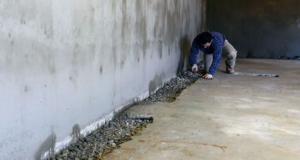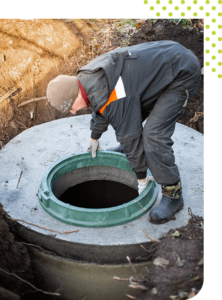Basement cracks that aren’t repaired allow water, mud, bugs and radon into your home. Bowing walls indicate structural damage and can collapse if not addressed promptly.
Larger cracks in basement walls should be assessed by a professional to determine their cause. They may require wall anchors or braces to stabilize them over time. Click the Basement Repair Naperville IL to learn more.

As basement cracks get worse, they can affect the structural integrity of the house, which can increase maintenance costs and lower property value. As a homeowner, you will need to address these issues as soon as they appear. While the most common cause of a basement wall crack is shifts in the foundation, it can also be caused by soil settlement, hydrostatic pressure and freezing and thawing cycles. If not addressed, these problems can lead to a weakened foundation that could collapse over time.
The first step in basement crack repair is a detailed inspection to assess the length, width and depth of the crack and identify underlying causes. This will determine the best repair method for your home. For example, if your basement wall is bowing or leaning, a carbon fiber reinforcement system can be installed to stabilize and straighten the wall. This is a less invasive option than installing wall anchors or braces, but may still require professional assessment and installation.
If you’re experiencing the telltale signs of a basement crack, such as countertops and cabinets that are pulling away from the wall, it’s important to hire professionals for basement crack repair as early as possible. They will be able to identify the issue quickly and integrate waterproofing measures into the repair to prevent future leaks. While hiring a professional will cost more upfront, they offer long-term cost savings through waterproofing and preventing additional damage to your foundation and the rest of your home.
A professional will start by digging a 2’ x 2’ hole centered on the crack and cleaning the area around it. They will then inject the crack with hydraulic cement, which is designed to resist hydrostatic pressure and expand in the crack as it dries to create a tight seal. After the crack is repaired, a layer of waterproofing material will be applied (typically some form of a vapor barrier). Finally, experts will backfill the hole, tamping down the dirt as it’s returned.
For exterior cracks, a similar process is used to ensure a watertight and strong repair. A vapor barrier is applied to the crack followed by a coating of concrete waterproofing mastic. This mastic is the same material we use to encapsulate basements and helps to protect the epoxied crack from moisture and other contaminants.
Interior Crack Repair
Your basement’s foundation is the very structure your house sits on and, therefore, it requires a lot of care and attention. If neglected, basement cracks and structural damage can become serious problems that compromise the integrity of your home. The good news is, when problems occur, there are a variety of repair methods to address them, from exterior crack sealing to more advanced carbon fiber reinforcement techniques.
The location of your basement cracks is a key factor in selecting a repair method. Smaller, hairline cracks can be addressed with interior repairs that inject a specialized polymer into the crack. This method is less invasive, can be carried out under any weather conditions, and requires significantly less manpower than external repair methods. However, if your basement is unfinished, or has significant physical obstructions within it, the interior crack sealant may not be as effective as an external option.
Besides sealing a basement crack, a comprehensive basement repair project will include waterproofing measures. Exterior waterproofing involves excavating around your home’s foundation and applying a waterproof membrane. Interior waterproofing addresses existing leaks and moisture by incorporating drainage systems, sump pump installation, and the use of waterproof sealants.
Water infiltration is one of the most common causes of basement cracking. When not addressed, the resulting moisture can lead to mold growth, sagging drywall, and structural damage. By implementing preventive and reactive waterproofing solutions, your basement can remain dry and safe for years to come.
Bowing walls are a serious concern and a sign that your home’s structural integrity has been compromised. This issue is often caused by lateral pressure on basement or foundation walls, and it can be exacerbated by poor drainage, expansive soils, and freeze-thaw cycles. Bowing walls can cause serious structural damage and should be addressed as quickly as possible to avoid a potential collapse.
In addition to repairing the damage, a qualified professional should also inspect your basement for other signs of underlying problems. These signs can include a high water table, soil erosion, and signs of excessive moisture or mold. By addressing these issues early, you can ensure that your home’s foundation is in good condition for years to come.
Bowing Wall Repair
Bowing basement walls are a sign of significant structural damage, and they must be addressed immediately. Left unchecked, they can lead to catastrophic wall collapse and a shattered foundation. Fortunately, there are several basement repair methods that can restore bowing walls to their original load-bearing shape.
Bowing walls are typically caused by soil erosion or pressure from outside. Water-saturated soil can exert hydrostatic pressure against basement walls, and this can be even more intense if the ground freezes. Pressure can also build up from heavy driveway or patio paving elements that put additional stress on the wall, as well as from hidden plumbing leaks.
If a bowing basement wall is caught early, it can be repaired using minimally invasive methods like carbon fiber straps or wall anchors. However, if a basement wall has bowed more than 2 inches, more extensive piering or even replacement may be necessary.
It’s important to have a quality inspection conducted by a professional to identify any bowing walls and determine the best repair solution. The expert will look at the basement walls from both inside and outside the home, as well as measure them at different points to assess the extent of the bowing. A concrete contractor will also perform a pressure test on the soil to check for excess water or pressure that could be pushing against the basement walls.
The most common solution for bowing basement walls is helical tiebacks, which are long steel screw-like shafts drilled through the interior of your basement and into the soil outside your home. The shafts are then twisted until they reach a specific torque, which straightens the wall. This method is the most expensive for repairing a bowed basement wall, and you can expect to spend about $1,500 per tieback. A typical 20-foot wall will require a tieback every 5 feet, so you can expect to spend about $80 to $140 per foot for this type of basement brace.
Another option for bowed walls is to install brackets on both the interior and exterior of the wall and insert steel rods through them. The rods are then tightened to exert pressure on the wall, gradually straightening it over time. This is a more costly solution than the previous option, but it offers the benefit of being able to repair the wall without excavating the surrounding soil.
Foundation Crack Repair
Foundation cracks can cause problems such as allowing water to leak into basements and crawl spaces, which can promote mold and mildew growth. The cracks can also allow harmful soil gases such as radon to enter the living areas of the home. Sealing and repairing these cracks helps keep water and gases from entering the living area, and helps prevent structural damage.
When a non-structural crack appears, homeowners should have it repaired by professionals. A professional can use carbon fiber straps to strengthen the crack and prevent it from expanding and potentially causing further damage. This solution is cost effective and can usually be completed in one day.
For a more permanent repair, a specialist can install a wall restoration system such as EverBrace. This system is inserted into the existing foundation without requiring full excavation of the basement. The surface of the foundation wall is cleaned and prepared for bonding, and carbon fiber strips are bonded to it using high-strength epoxy resin. A second layer of epoxy is then applied over the straps to ensure a strong and durable finish.
Bowing walls are a serious issue and should be treated as soon as possible. These walls are caused by up-and-down movement of the soil around your home’s foundation. The problem is typically due to frost-heave, where the ground rises when it freezes, and then sinks when it thaws. This movement can cause your basement foundation walls to lean, bow, or shear. In most cases, a bowing basement wall can be fixed with wall plate anchors. These are installed by attaching an inside plate to the bowing basement wall, and then connecting it to an outside anchor in the dirt around your home.
A concrete support pier system is another option for fixing bowing walls. These piers are installed under the foundation of your home, and transfer the weight of your home to them. This fixes the bowing and prevents it from worsening. A repair plan will pinpoint where these supports are needed, and most of the time they are placed along the perimeter of your house. In about 10% of cases, supports may also need to be installed under the middle of your home.
